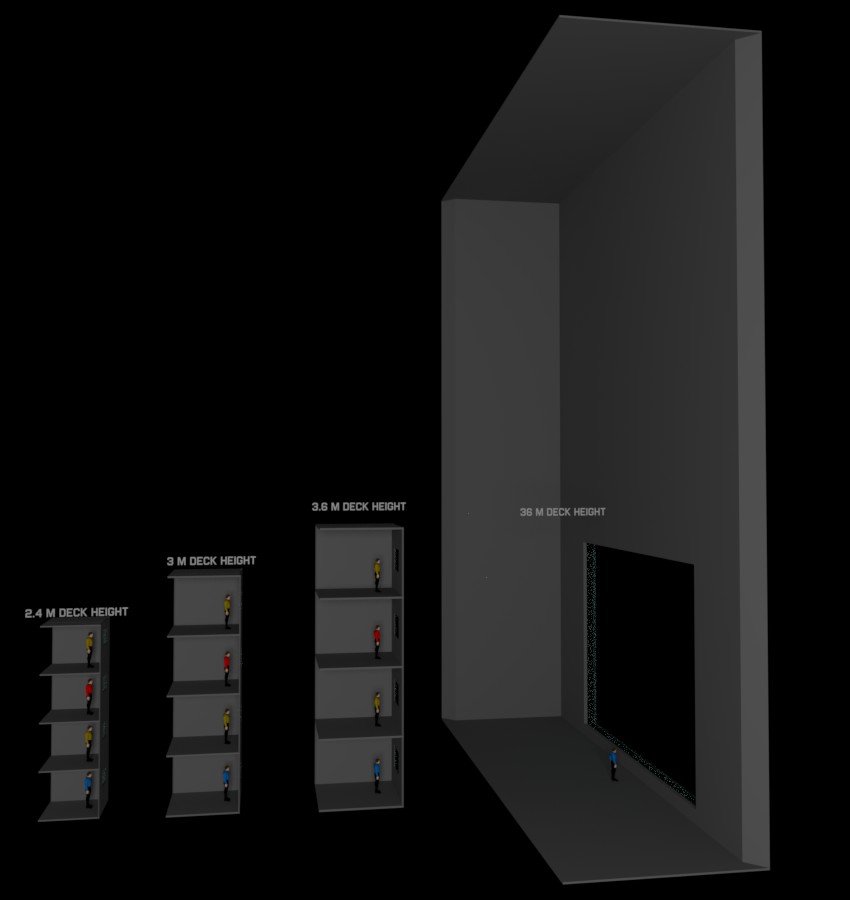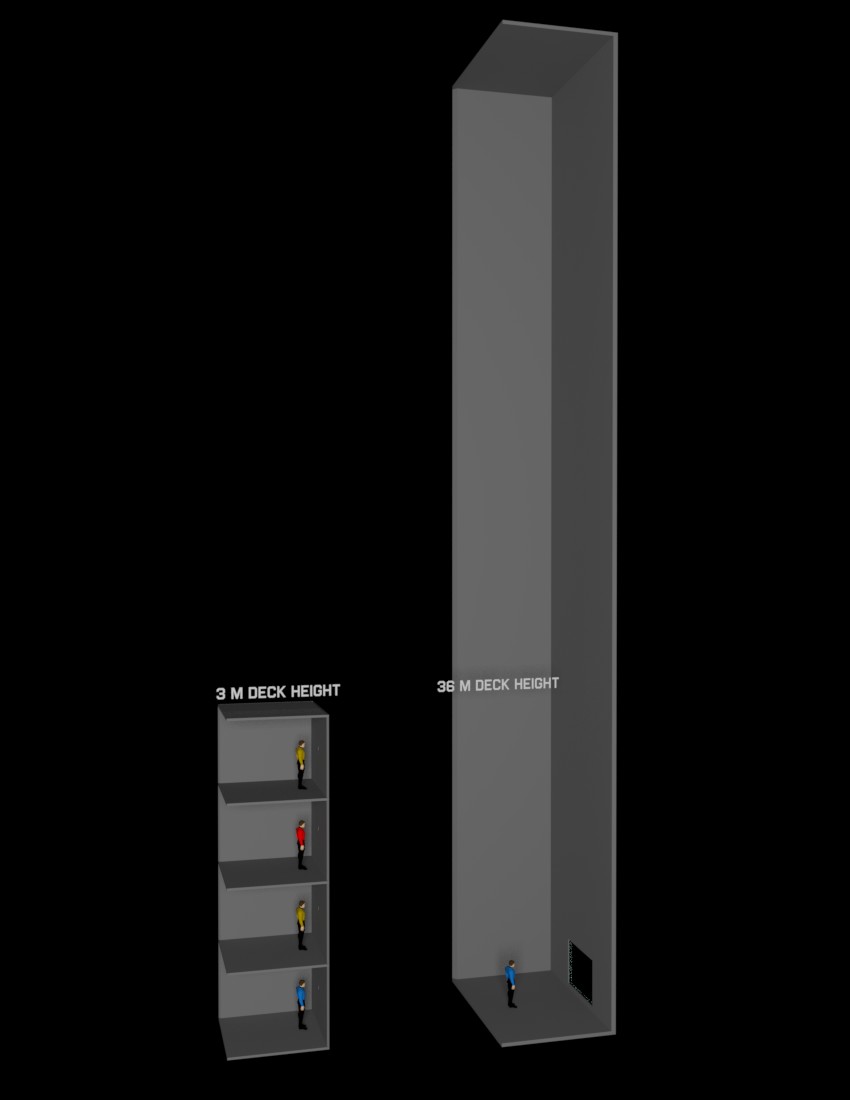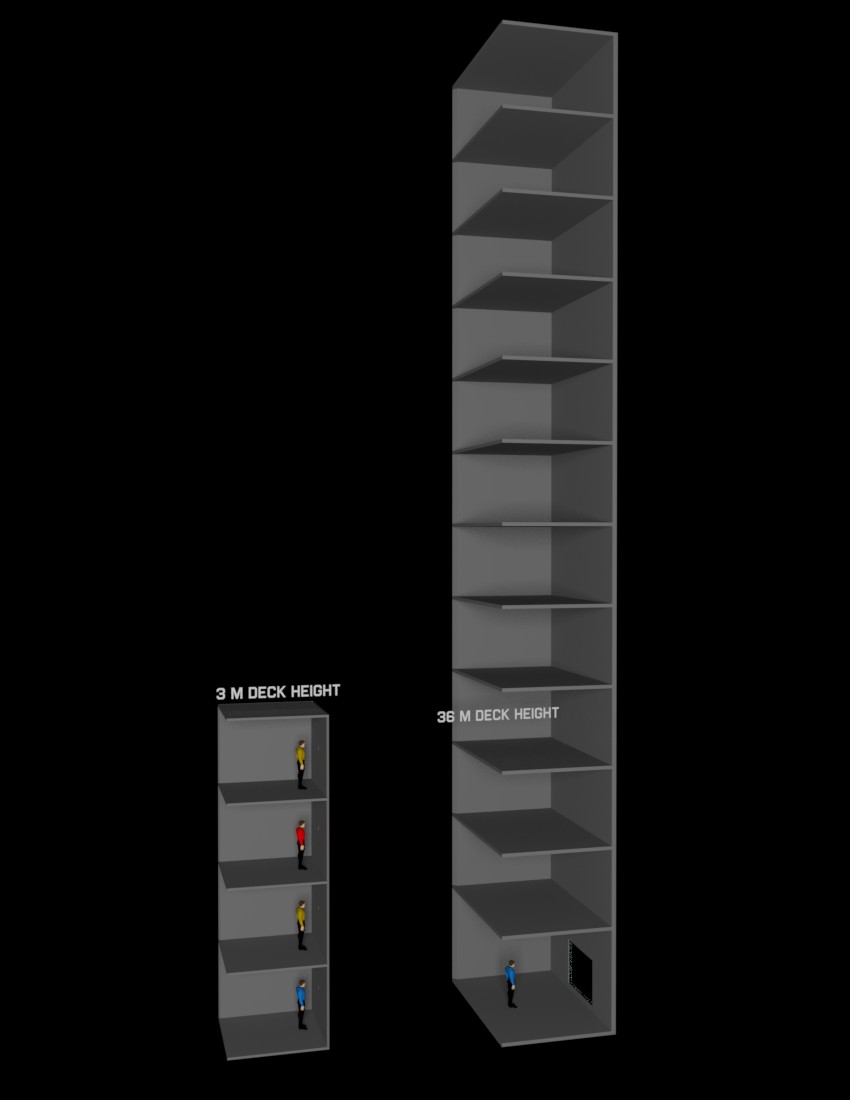There is a fantasy of mine that, whenever a new vessel appears on the view screen of the USS Voyager, something like this will follow :
| Janeway : | "Identify it, Mister Kim." |
| Kim : | "It's a Bugomite vessel, Natharr class." |
| Janeway : | "What, you mean the frigates they introduced in 2367? The ones that are two hundred and fifty metres long, eighty five metres wide, thirty six metres high, have eleven decks, mount six type four disruptor cannon, have a top speed of Warp 9.4, and carry a crew of sixty five?" |
| Kim : | "Those are the ones, captain." |
Okay, so this might leave the bulk of the audience scratching their heads and wondering what the hell was going on - but it would sure make the lives of those fans who run technical web sites easier!
But it certainly would be nice if, when a new ship was created, somebody actually sat down and spent an hour drawing up some basic specifications on it and then put them into some kind of central reference system that writers and special effects guys could look up. And I'm not talking really detailed stuff, either - one of the most astounding things about the ships of Star Trek is that, for the most part, the creators of the show have no clear idea of such basic information as the length of the ships they are dealing with.
This lack is compounded by the fact that many of the models used for the show are built to completely different scales, and the technology in use for much of The Next Generation and Deep Space Nine meant that it was not always possible to show ships correctly sized relative to one another within the time and budget available. And there are even occasions on which the creators deliberately make ships look bigger or smaller in order to emphasize or de-emphasize their strength.
For fans who believe that everything seen on screen is an absolutely correct and accurate depiction of what 'actually' occurs within the fictional universe that is Star Trek, this leads to a problem. For in seeing the same model depicted at various different sizes, we are led to the conclusion that ships are being built in different sizes, without any alteration whatsoever in their shape.
This brings up a potential problem, sometimes referred to as the 'ant problem'. The name refers to science fiction movies of the 1950s and 1960s in which something - usually radiation - caused insects such as ants to grow to fantastic sizes so that they could then present a suitably scary sight to the heroes and audience. Some of the movies would put great emphasis on how amazingly strong ants are. 'An ant is able to lift seven or eight times its own body weight,' goes the argument, 'so just think how strong this monster must be!'
The problem becomes obvious when we consider the ratio between the structural strength, muscle power and weight of such an animal. If you take any object and scale it up by a factor N whilst keeping the exact same shape and materials, then the surface or cross sectional area of the shape (or of any given element of it) will increase by a factor of N2, whilst the volume will increase by a factor of N3. The weight of the object rises in direct proportion to its volume while the structural strength at a given point rises roughly in proportion to the cross sectional area at that point. For a living thing the muscle power also rises roughly in proportion to the cross sectional area, which is why Arnold Schwartzenegger is such a tough guy with all those bulging muscles.
If we want to increase the size of our ant from one millimetre to ten metres we must scale it up by a factor of 10,000. So the cross sectional area of its skeleton and muscles at any given point will increase by a factor of 10,0002, or 108, but its mass will increase by a factor of 10,0003, or 1012.
Which means that far from being super strong, our ant has become ten thousand times weaker that it was when compared to its size! Such an enlarged animal could not possibly lift its own body weight, let alone tear down buildings or chomp up mad scientists. Indeed, our super ant's skeleton would more than likely just fracture and collapse under its own weight.
But we know that there are indeed very large animals in the world. So how does nature get around the ant problem? Well, take a look at an elephant compared to an ant :

Look especially at thickness of the legs. The elephant's legs are much, much thicker than the ant's are in proportion to the overall size of their bodies. The larger you are, the thicker your legs have to be - assuming you use the same building materials, of course.
I trust you can see how this relates to Starships. If we took the Enterprise-D and simply scaled it up to ten times the size, we would have a vessel almost six and a half kilometres long. The skeleton structure would be about one hundred times stronger than the existing Galaxy class - but the vessel's mass would be almost five billion metric tons, one thousand times greater than the existing ship. So overall, the ship's structural strength would be one tenth that of the current version.
Hence the 'scaling problem'. We've seen ships in Star Trek which are, apparently, simple scaled up versions of each other. Yet how can they be? There are several possible answers.
By far the simplest answer is that the ships are not scaled up internally the way they are externally. It hardly needs saying that one ship cannot be a perfect scale up of another, or else we have in mind the image of Picard sitting on a gigantic bridge in a massively oversized chair, idly swinging his legs several feet above the floor! Obviously stuff like chairs aren't scaled up. Nor is there any real reason to believe that the skeletal structure of a ship is scaled up in perfect proportion.
Assume that we have a ship which is exactly 50 metres long, and which has an internal structural skeleton composed of beams measuring 100 x 100 mm in cross section. If we now create a new class identical to the first in external shape but twice the length, the structural beams now measure 200 x 200 mm, giving a fourfold increase in strength, but the mass will rise eight fold.
But what if we simply increase the size of the beams to 283 x 283 mm? Now the strength is in line with the new mass, and our problem is solved. Remember, this is essentially identical to the difference between the ant and the elephant - scale the body up by one factor, but make the structural support provided by the legs greater by scaling them up even more.
The only real limitation on this solution is that the expanded structural skeleton is going to take up a greater proportion of the ship's volume, and that eventually you will reach a point where there are no gaps left between the structural beams. Just as you would end up with an animal that was all legs if you kept making it bigger and bigger. But these kind of practical limitations aren't going to be a problem for scale ups of four or five, which would cover the majority of the ships we have seen scaled up in Trek.
|
Structural Integrity Field |
Another possible solution lies in the device known as the Structural Integrity Field.
This system is described in The Next Generation Technical Manual; it projects a force field over the structure of a spacecraft in order to stiffen and strengthen it far beyond the normal limitations of its materials. Indeed, the book claims that without the SIF the structure of a Galaxy Class Starship is so weak that if you placed it on the ground, it could not even support its own weight.
'Star Trek : Generations' establishes that the saucer section of a Galaxy class starship can certainly support its own weight against one standard gravity, although this isn't to say that the structure of the whole ship would. Certainly the neck would be hard pressed to support the huge saucer section, if the materials used are within an order of magnitude of present day materials.
Whatever the true strength of the Galaxy class structure, there is plenty of support in canon for the existence and function of the SIF system. Many examples of a Starfleet vessel facing severe forces in some emergency are accompanied by dialogue referring to the SIF system.
So, there is no real need to mess about with the thickness of your structural beams as described above; larger ships may simply have more powerful structural integrity fields in order to compensate for their relatively weak structure. The only real problem with this explanation is that any scaled up ship would be in really serious danger if it lost power to its SIF. But then, this is exactly what the TNG TM claims is the case.
Of course, looked at from the other direction, this is just saying that the reliance on the Structural Integrity Field is reduced as the ships get smaller, which would actually be a benefit to the ship as it would free up the power for other systems.
A far more pressing issue than strength is deck heights. Most Star Trek ships are said by their designers to have decks about 3 - 4 metres tall, including some space between them for wiring etc. If a ship is scaled up by a factor of ten or twenty percent, then this is not much of a problem because we can simply assume that the larger ship has decks which are, say, 3.6 metres compared to 3 metres. As you can see in the diagram, all this really means is that the windows and headroom on any given deck are a little larger :

A set of decks, plus the same set scaled up by 20% and scaled down by 20%.
But this argument falls apart with ships like the Klingon Bird of Prey. Certain scenes make this ship look like it is 50 metres or so long, while others make it look well over 600 metres! Whilst there is nothing fundamentally impossible about a ship which has decks around forty metres high, it does rather strain credibility.

Problematic!
There are two obvious problems there. One, the deck itself is absurdly tall - well over a hundred feet. But almost as bad is that the window is comically huge.
However, there are solutions here! Let's think about the window. We need to establish the ratio between the maximum credible window size, and the minimum credible window size.
What's the biggest window you could credibly have? Obviously, it's going to be a floor to ceiling window on the tallest deck you could credibly have - which is going to be in the 3 m range.
What's the smallest window you could credibly have? Well, look at portholes on ships. Some of them are only 15cm or so across.
Which means you could credibly have widows in one ship that are
twenty times the size of windows in another, if you assume that the first ship is fitted with small porthole-style windows and the second with big impressive windows. Take this image : the windows in the decks on the left are 15 cm high and 21.5 cm wide - 6 inches by 8.5 inches. A damn small window to be sure, but no smaller than the portholes you would find on many a small ship or boat. On the right, we have a window that measures 1.8 m tall by 2.57 m wide - 5'11'' by 8'5''. It's not even a floor to ceiling height - it's about the height of an average human male, and certainly narrow enough to comfortably fit a rather modest room.

Little windows to big windows...
But of course, it still looks absurd because the deck itself is nonsensically tall! More than a hundred feet tall, in this case.
But again, there are solutions. All we need to do is substitute two decks for one - or three decks, or however many are needed to fit the scaling factor. In this case, we have scaled by 12 so we substitute 12 decks for one :

Extra decks, and our problems are solved!
Of course, the downside to this is that it presumes that those 11 extra decks don't have any widows at all in them. But then... so what? There's no rule that a ship must have windows on any given deck. The Constitution class from the original series had decks in the ventral saucer section with no windows in them at all, and nobody seems to mind that at all. In fact the original Constitution had rather few windows at all. Those decks in the saucer that did have windows tended to have maybe eight or ten at most. And for the interiors, think about it - how many times did you see ANY room in that ship with a window in the wall? Almost never, that's how many. Yes, that was because they didn't have the special effects budget to show rooms with windows. But it still establishes within canon that windows are pretty much optional - as if that really needed to be established!
Now this works fine for ships where the scaling factor is an integer, but this is not usually the case. Even so, it's relatively easy to create a combination of multiple decks and changed deck heights to account for virtually any scaling factor. For example, a scaling factor of 2.3 can be accounted for by having twice as many decks, each 1.15 times as high.
But in general, if we can accommodate a scaling factor of 12 then we can accommodate pretty much any other scaling factor in Trek.
It's a truism that a real designer would simply avoid all of the above problems by coming up with a completely new design in the first place of course, but the fact is that the ships are indeed there on screen, so if we do accept the images as fact then we must believe that the designers did choose to do this damn stupid thing. Whilst I've never been one to insist that everything seen on screen is a perfectly literal representation of actual events, I do like to incorporate everything which is not contradicted by other canon sources. In the case of scaled ships, there's nothing in the canon to show that these do not in fact exist, so for the purposes of this site I go with the idea that certain ships are indeed scaled up or down.
In reality, my personal feeling is that the strength problem would probably be resolved by a combination of factors. A scaled up ship most likely has a combination of a beefed up structure and a more powerful structural integrity field. The former would ensure that the structure would meet whatever minimum strength the designers felt was necessary, while the latter would save on the materials required to build the ship, so reducing resources cost and build time. This kind of detail is virtually never revealed about ship designs either on or off screen - the rare Tech Manuals are the only sources which give figures that can be considered even vaguely trustworthy. So for the most part we can just make a generalized assumption about the changes to the structure and leave it at that.
The deck problem is a little more tricky, since the solution depends on the scaling factor involved. All we can do for this is deal with each problem on a case by case basis.
Colour key






